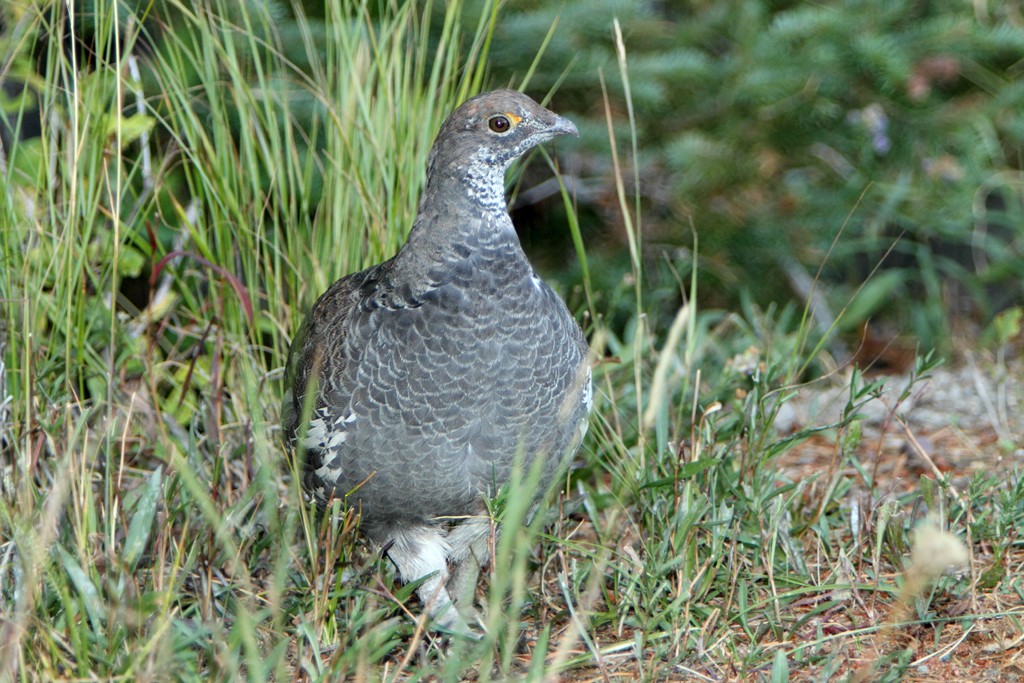Dusky Grouse
A species of Blue Grouse Scientific name : Dendragapus obscurus Genus : Blue Grouse
Dusky Grouse, A species of Blue Grouse
Botanical name: Dendragapus obscurus
Genus: Blue Grouse
Content
Description People often ask General Info
Description
Adults have a long square tail, gray at the end. Adult males are mainly dark with a purplish throat air sac surrounded by white, and a yellow to red wattle over the eye during display. Adult females are mottled brown with dark brown and white marks on the underparts. Their breeding habitat is the edges of conifer and mixed forests in mountainous regions of western North America, from southeastern Alaska and Yukon south to New Mexico. Their range is closely associated with that of various conifers. Their nest is a scrape on the ground concealed under a shrub or log. They are permanent residents but move short distances by foot and short flights to denser forest areas in winter, with the odd habit of moving to higher altitudes in winter. These birds forage on the ground, or in trees in winter. In winter, they mainly eat fir and douglas-fir needles, occasionally also hemlock and pine needles; in summer, other green plants (Pteridium, Salix), berries (Gaultheria, Mahonia, Rubus, Vaccinium), and insects (particularly ants, beetles, grasshoppers) are more important. Chicks are almost entirely dependent on insect food for their first ten days. Males sing with deep hoots on their territory and make short flapping flights to attract females. Females leave the male's territory after mating. 
Size
48-53 cm (19-21 in)
Colors
Brown
Black
Gray
Life Expectancy
1-14 years
Nest Placement
Ground
Clutch Size
1 - 12 eggs
Incubation Period
1 brood
Number of Broods
25 - 28 days
Nestling Period
1 - 2 days
Feeding Habits
Dusky Grouse's diet includes conifer needles, buds, deciduous leaves, herbs, berries, and insects such as grasshoppers, beetles, ants, and spittlebugs. They feed mainly on the ground but will forage in trees for shoots and fruits, primarily at dawn and dusk. In winter, they subsist on conifer needles and buds, selecting mainly the outer portions, while their summer diet is more varied with additional plant matter and insects.
Habitat
Dusky Grouse inhabit deciduous and mixed mountain forests, particularly areas with species like firs, ponderosa pines, and aspens during summer. Their habitat extends to adjacent grasslands and shrubby zones rich in insects and seeds. Seasonally, dusky Grouse ascend to higher elevations with dense coniferous forests, or migrate downwards, showcasing flexibility in habitat choice.
Nest Behavior
During the nesting period, dusky Grouse females build isolated nests away from males and others. They lay and incubate eggs with minimal influence from males, offering parental care to both eggs and hatchlings.
Nest Characteristics
Dusky Grouse's nests are ground constructs found in habitats ranging from shrubsteppe to alpine krummholz. Females favor locations with overhead cover like shrubs or logs. Their shallow scrapes measure about 6.7 inches across, lined with local detritus and feathers.
Dite type
Herbivorous
People often ask
General Info
Feeding Habits
Bird food type
Behavior
Dusky Grouse's begin their breeding season in early spring, performing display flights to attract mates while defending their territories. They exhibit promiscuous mating, with males courting each female that enters their territory through elaborate displays, including hooting and physical posturing, highlighting their colorful neck sacs. While solitary outside the breeding season, females are aggressively protective of their young, employing distraction displays against predators and even engaging in physical confrontation if necessary. After autumn, the young dusky Grouse's are fully grown and start leading independent lives.
Species Status
Not globally threatened.
